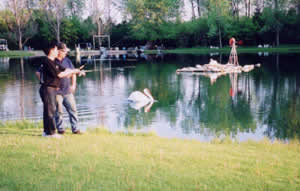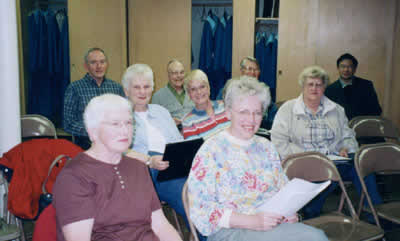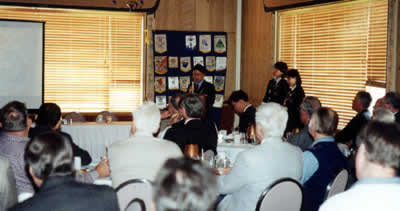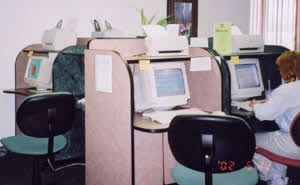
Senior Staff, Policy Coordination Division
Osaka Prefectural Government
Sponsored by the Osaka Shirokita RC
1. Introduction
The state of Wisconsin in America is known for its beer, dairy farming, and
high level of education. For a month from May 1 to May 31, I was able to join
the GSE team which went to D-6270, which is in this Midwestern state. Wisconsin
is filled with natural beauty and has 15,000 lakes. I was able to have many
valuable experiences there.
My research theme for this trip was the United States' labor situation and
employment policies, and I was able to reap great benefits from exchanging opinions
on a wide variety of topics with those I met during my vocational study trips,
etc. Besides this, I was able to have precious experiences by having homestays
with six American families. Looking back on that month, I will give an account
in this paper of the things which I was deeply impressed by, especially the
differences I became aware of between America and Japan.
2. Features of Wisconsin and Milwaukee and my Impressions
Land Area and Population
Wisconsin's land area is about 145,450 square kilometers (56,150 square miles).
Japan's land area is about 377,800 square kilometers (145,900 square miles),
so just this one American state equals about 38% the land area of the country
of Japan.
On the other hand, the population of this state is 5,250,000 (in 1999), a mere
two-thirds of the population of Osaka Prefecture. Even the state's largest city,
Milwaukee, is home to only 610,000 people. One of the things I noticed immediately
after reaching Milwaukee (and which surprised me) was the great amount of land,
the beautiful lawns surrounding houses, and the people's leisurely life-style.
Wisconsin's representative city of Milwaukee was the center of our visit, but
we also visited four neighboring cities - Waukesha, Oshkosh, Port Washington,
and Hartland.
Features of Milwaukee
Milwaukee's name is derived from the Algonquin Native American word Millioki,
which means "Waterside Council Place." It is said that from a long
time ago, this area developed as a council site for those who visited Millioki,
which was where three rivers converged before flowing into a lake. That lake
is Lake Michigan, which is located along the eastern side of Milwaukee. I was
able to see the lake up close several times while I was in the area, and that
lake truly seemed like an ocean.
Many German, Polish, and Irish immigrants moved to Milwaukee, and they are
the ones who built the beautiful present-day city of Milwaukee. Milwaukee is
famous for its beer, sausage and cheese, which come from the German traditions.
A drive of just five minutes from downtown Milwaukee, where high-rise buildings
line the streets, will take one through orderly residential areas, and a drive
of ten more minutes on an expressway takes one to where the rows of houses give
way to pastures and corn fields.
But this is not the true countryside at all. Here, Miller beer (which is imported
to Japan) and the world-famous Harley Davidson motorcycles are made. Some of
the nation's few exemplary manufacturing and medical instrument-making industries,
among other industries, exist in this area. Also, the Brewers (professional
baseball) and the Bucks (professional basketball) are both from Milwaukee, and
are popular teams which attract many fans during their respective seasons. I
was able to see a weekend baseball game at Miller Park where the Brewers played
the Chicago Cubs. A crowd of 40,000 or more fans gathered to cheer excitedly
at that game.
3. My Experiences in America (What I Saw and Felt in Wisconsin)
I was very interested in the life-styles of Americans, who live not only in
a much larger country but historically and culturally greatly differ from Japanese,
long before I went on this trip to Wisconsin. I will now introduce part of the
American life-styles (what I saw on my trip).
A. Living Space
The part of the United States I visited is a part of the prairie that stretches
across the American Midwest. There are few mountains in this area, and because
the population density is so low in this state, plenty of space for residential
lots, roads, parks, schools, etc. is available, and people can live very freely.
Homes close to Milwaukee's downtown are comparatively close to the houses next
to them, but even most of these had front and back yards with beautiful lawns
and from several to several dozen trees. The land areas of the large-sized homes
I saw far exceeded what I had imagined, with some of them large enough to have
their own man-made lakes and private airfields!
Many houses were two-story homes, and almost all the homes had basements. Those
basements were made into rooms with large televisions for watching movies, game
rooms for enjoying billiards or table tennis, offices, and other rooms according
to how the owner of that particular household wanted to use the space.

Enjoying fishing with my host family
B. A Car-Driving Society
In a place with such wide spaces, living without a car is impractical. Of course,
government offices, shopping centers, baseball stadiums (like Miller Park),
and other places where people gather, have enormous amounts of parking space.
Also, since people are allowed to get a driving license at age sixteen, many
students drive to school when they become high-schoolers.
At the home of one host family, which owned five cars for four family members,
America's decision to not follow the Kyoto Protocol became a topic of conversation.
I said to that family, "I don't feel so good about you each having your
own car and emitting large amounts of carbon dioxide every day. You should use
bicycles and other means of transportation as well." I was told, "We
know that it's bad for the environment, but if we used bicycles and lived our
lives the same way we do now otherwise, we would have to ride bicycles two or
three hours every day." In Wisconsin, where cars are the "legs"
of everyone's life-style, taxis are rare even in downtown areas (Of course,
I think that this would not be true in a large city like Chicago, Illinois,
south of Wisconsin.).
C. People's Living Patterns
The people in Wisconsin generally wake up one to two hours earlier than Japanese
people. Most of the Rotarians who took care of me woke up about five o'clock
in the morning and started work at around seven. There were some people who
woke up even earlier to work out at sports clubs or swim (there were public
high schools which open their pools year round only in the morning) before going
off to work. We went to four of the Rotary meetings from seven o'clock in the
morning, and from these experiences I was impressed with the fact that Americans
are extremely energetic people.
The working people in America not only went to work early, they also ended
work early -- around four in the evening -- and then they were free to use the
rest of the day as they wished. Some went to movie theaters in the evening,
practiced Judo at the YMCA as a family, or used the precious time with their
families in other ways.
D. Regional Communities
The Americans I met treasured their private time after work, but at the same
time, they emphasized their ties with their region and communication with many
people. Of course, Rotary activities also treated relationships built around
common interests, chances to worship together at churches, and other interactive
experiences as very important. I went to church with one host family early Sunday
morning. Before the service, they exchanged recent news with friends, and then
after the service, they went out with other friends to have breakfast at a restaurant.
They said that this was a pleasure they had weekly. The large restaurant we
went to that week was full at 8:30 in the morning, which would be hard to imagine
in Japan.

Practicing a song in the early evening at church with people from the area
E. American Greetings
Americans exchange greetings often. People who know each other say, "Hi,
so-and-so." "How are you, so-and-so?", greeting each other by
name, and then exchange recent news quickly before saying, "Good to see
you," and ending their conversation. Sometimes, people repeated that same
conversation pattern with each other in only a few hours. Even people I didn't
know would say, "Hi!" or "Hello!" to me as we walked by
each other while I was walking my host family's dog. At the supermarket checkout
counters, I was asked "How are you today?" I would reply, "Fine"
or "Good," and after the checkout, the cashier would say, "Have
a nice day," to which I replied "You, too."
At first I was bewildered at how often Americans greeted each other and thought
that they must get tired greeting each other so often, but I realized later
that this was like a social lubricant that creates a sociable atmosphere, and
I gradually got used to the frequent greetings.
F. The U.S. Flag and Patriotism
I saw the American Stars and Stripes in all kinds of places. In front of public
buildings and businesses, and near many homes' doors, large American flags were
flying -- and not only on holidays. T-shirts and hats with the U.S. flag design
on them were sold at many places, and many people were wearing such apparel.
The Rotary meetings always began with the Pledge of Allegiance to the United
States of America. The short history of the United States and the wide variety
of peoples living there differ from Japan, but I thought that the Americans
are receiving proper education to have patriotism instilled in them regardless
of their ethnic background.
G. A Donating Culture
On this GSE trip, I visited many wonderful institutions which were supported
by individuals. I had not expected to hear the word "donation" concerning
citizens' theaters, day-care centers, an excellent gymnasium complete with an
auditorium (on the University of Wisconsin campus), rehabilitation centers for
wild animals, and other facilities, as often as I did.
Some people say that they donate because they receive tax exemptions for their
donations, or because they do it as a religious practice, but I felt that the
autonomous spirit that said "Let's give money for the cause of making our
city better" was the true reason for the donating culture I saw.
Thinking of the donations, I was reminded of President John F. Kennedy's inauguration
speech, when he said, "And so, my fellow Americans: ask not what your country
can do for you -- ask what you can do for your country."
H. My Introduction of Japan and Americans' Responses to It
In the same way as I was interested in American culture and life-styles, Americans
were interested in Japan and how people live here. Introducing life in Japan
and exchanging ideas was very fun for me. At the Rotary meetings, I made presentations
about Japan and Osaka. I made a presentation of Osaka City's geography, streets,
population, industries, history, life-style, food, traditional entertainment,
and sports using slides, and I gave explanations about them. People told me
that they were able to understand my presentation well and that it was interesting.
My host families also talked with me a lot about living in Japan (residential
conditions, the food we eat, children's education, work, vacations, etc.), and
while we knew that we had differences in our customs and living patterns, we
realized that people in both the United States and Japan all wanted to enjoy
and improve their lives.

Giving my presentation at a Rotary meeting
4. Working Conditions and Employment Policy in the United States
My vocational study theme was the study of American working conditions and
all types of employment policies. I visited three Workforce Development Centers
(institutions that allow companies and job applicants to receive information
and services related to employment, education, training, etc. These centers
contain both public and private job-related offices, with a public employment
agency as the main emphasis) and one private vocational training center and
one private manpower agency. I was able to ask many questions about America's
working conditions from many perspectives. In addition, I was able to hear Rotarians'
and host families' views on their jobs.
A. Americans' Occupational Consciousness (Based on the Opinions of Rotarians
and others) and the Background Behind those Feelings
・They do not work with the goal of being a member of some important organization,
but to improve their careers and be highly valued in the labor market. And many
people think, "If I have a chance to, I'd like to go into business for
myself."
・In order to realize that dream, they set high goals for themselves in university
and are deeply interested in gaining college degrees. Even if they join the
labor force once, a good number of people will return to university to take
courses again.
・Both companies and individuals accept job changes as a positive thing. In fact,
it is normal to change one's job and/or company at least a few times in one's
life. (Public officials do the same thing. Many people were surprised when I
told them that I had worked at the same government office for fifteen years
after graduating from university.)
・I asked a few people what they thought about the lifetime employment system
which the Japanese have embraced for a long time. I was told, "For a company
that is growing, it's a good system. However, when society and the economy are
changing, companies and individuals need to always be adjusting to those changes,
and using such a system under those circumstances would be difficult. A seniority
system is unfair. Proficiency and skill should be properly appraised, and age
and the number of years one has been with the company have nothing to do with
skill."
America's workforce is made up of people who think this way, and there are many
areas where they think differently than Japanese. Also, the following points
show how America's own particular conditions are different from Japan's:
・The percentage of workers who are members of labor unions in America is lower
than in Japan (13.5% in America, 21.5% in Japan, as of 2000).
・There are no laws that regulate laying off employees (however, federal law
and some state laws protect workers from being laid off because of one's race,
religion, gender, native country, age, or union activities).
・There are two main types of wage-paying systems in the United States. An annual
income is given mainly to managers, professionals, and others (called "white-collar
workers"). All other workers (called "blue-collar workers") receive
hourly wages. The salary raise the white-collar workers receive the following
year depends on the degree to which they achieved their goals the year before.
B. America's Unemployment Situation and its Characteristics
After America's unemployment rate plunged to a low of 3.9% in October, 2000
because of long-term business expansion, the economy's decline and stagnation
led to an increase in the unemployment rate. Economic recovery is foreseen,
but the unemployment situation is worsening (the April, 2002 unemployment rates
in the United States and Japan were 6.0% and 5.2%, respectively).
The conventional features of American unemployment is that the unemployment
rates are especially high among African Americans and Hispanics, and that the
number of unemployed white-collar workers is rising. Like Japan, restructuring
of businesses leading to laying off of professional managers and transferring
of office-work to computer networks are the suspected reasons for the growing
number of unemployed white-collar workers. However, the American white-collar
workers generally remain unemployed for a shorter time than Japanese white-collar
workers do.
Table 1
A Comparison of Lengths of Unemployment in Japan and the United States (in 1999)
percentage
Total Less than 1 month 1 month to less than 3 months 3 months to less than
6 months 6 months to less than 1 year 1 year or longer
Japan 100 12.8 24.3 18.2 22.0 22.4
United States 100 43.7 31.2 12.8 5.5 6.8
Sources: Special Labour Force Survey (Japan), BLS "Employment and Earnings"
(U.S.A.)
C. Labor Market Supply and Demand Coordination System
The Labor Department of the American government defines the framework within
which labor standards and labor market policies must be made according to the
Constitution. The individual states perform the actual public employment and
services designed to aid job applicants in that state. These public employment
agencies are state institutions, and although the federal government pays part
of the expenses of the education and training programs (which the states plan)
and pays for the unemployment insurance system's management, the individual
states decide on the contents of their unemployment insurance benefits and public
employment services. In these ways, the employment services are very different
from those in Japan.
Based on the federal government's policies, America's state governments establish
"one-stop career centers" (called Workforce Development Centers in
Wisconsin, where 72 of them exist) and give job hunters useful information,
advice, and other helpful services.
Although Japan is a leader in the use of IT (information technology) for providing
job-related information to its citizens, America has been using computers and
the Internet to provide such information since 1995, so the IT system came into
wide usage earlier in America than in Japan. All the states' IT systems vary
somewhat from others. In Wisconsin, there is a system in place where job openings
businesses are offering, the names of the companies, their contact information,
etc. are compiled and put on the Internet. Thus, job applicants can contact
employers without filing a job application at the employment agency.
Also, counseling and practice sessions for job applicants, as well as job interviews
conducted by businesses in coordination with the employment agencies and other
services, are available. Army veterans receive top priority services, while
the United States government is obligate to provide special aid in finding employment
to veterans wounded in combat.

Job hunters looking at help-wanted information at a Workforce Development Center
D. Coordination of Labor Supply and Demand by the Internet
Providing information on job openings on the Internet has taken root, and already
a total of more than 1,000 such public and private websites exist. The largest
website of this kind is America's Job Bank (AJB), which started service in February,
1995. This site integrates all job openings collected by individual states and
disseminates that information as a kind of nationwide job information website.
Also, on a state-wide level, a website called America's Talent Bank collects
resumes, information on desirable occupations, etc. from job-seeking individuals,
and provides that information to businesses, while taking care to protect the
job-seekers' private information. The difference between public and private
websites like these is that the AJB gives the most basic information on job
offers and covers all types of occupation opportunities, while the salary level
of jobs offered on private sites is relatively higher, and the information provided
is for more highly specialized workers.
E. Other Methods of Finding Jobs
People searching for jobs in the United States use many ways to find job opportunities
besides utilizing public or private job search facilities. Many people use two
or more different methods to find jobs.
Percentage of Job Seekers Who Used Each Method to Find Work
Through public employment agencies: 19.2%
Through private employment agencies: 6.9%
By negotiating directly with those offering employment: 64.6%
By filling out resumes or application forms: 48.6%
Through help-wanted ads: 15.9%
Through friends or relatives: 14.8%
Other: 8.8%
Average number of methods used by each job seeker: 1.79 methods
Looking at the scope of the activities of private institutions engaged in coordinating
labor supply and demand (job introducing and job placement), we see that 1,535,000
people were placed in jobs in 1990, while the figure was 3,230,000 in 1998.
The number has increased annually since 1990.
F. Employment Policy and Related Trends
Due to the progress of innovation of techniques and economic globalization,
the mechanics of employment is changing, and workers are not depend on one company
to provide them with job security. Instead, they are depending on their skills
and changing jobs a few times in their life in order to stay employed. For that
reason, employment policy that supports re-employment to help workers find work
at several different companies is being carried out. I realized that in this
way, the American and Japanese governments have many similarities when it comes
to labor policy.
Principle Employment Measures
・ Setting up of "One-Stop Career Centers"
These facilities, designed to provide employment, training, and other services
for businesses, job-seekers, students, and others, have developed across the
United States.
・ Carrying out programs that assist in re-employment
Some programs give unemployed people assistance in finding new jobs. Programs
are carried out in a way that provides the most suitable programs after the
government has ascertained the age, gender, occupational history, etc. of those
seeking to find new jobs.
・ Improvement of unemployment insurance system
Some businesses cut the working hours of their employees in order to keep from
having to lay them off. Such workers who receive less pay as a result of their
reduced working hours can receive financial assistance from the government before
they lose their jobs completely.
・ Coming up with vocational skill standards
In order to raise the national level of vocational skills, serious consideration
is being given to standards and a certification system that will promote the
creation of a nationally unified "vocational skill standard."
Sources: Government white paper on international labor information, 2002 edition
of Data Book of International Labor Situation(The Japan Institute of Labour),
The Japan Institute of Labour homepage, etc.
5. In Conclusion
I first heard about the Rotary Foundation's GSE activities in September last
year. My motive in joining the program was that I had read reports about past
programs written by participants, and I wanted to meet foreigners and experience
the same cultural exchange and mutual understanding that the other GSE participants
did.
From then, until I left for Wisconsin, I prepared myself by reading books pertinent
to my trip, made as many chances for me to practice English as possible, and
met with my four GSE team members almost every weekend for three months so that
we could prepare our presentations together. I think the reason this GSE program
bore fruit and was so fulfilling and meaningful was that all five of us were
able to earnestly make the most of our individual good points and cover for
each other when necessary. I am especially grateful to our group leader, Mr.
Satoh, who from the preparation period all the way through our trip to Wisconsin,
took care of the whole team and pulled us along.
And most of all, to all the Rotarians of the R.I. D-6270, who carefully planned
our trip and took care of us, and to the host families who gave us chances to
experience various life-styles, I want to express my sincere thanks.
Moreover, I want to say thank you to Chairman Nomura of D-2660, Coordinator
Matsuoka, those who have experienced the GSE program before me, and everyone
from the Osaka -Shirokita Rotary Club who recommended me and gave me appropriate
advice and warm words of encouragement when I needed it.
Thank you very much.